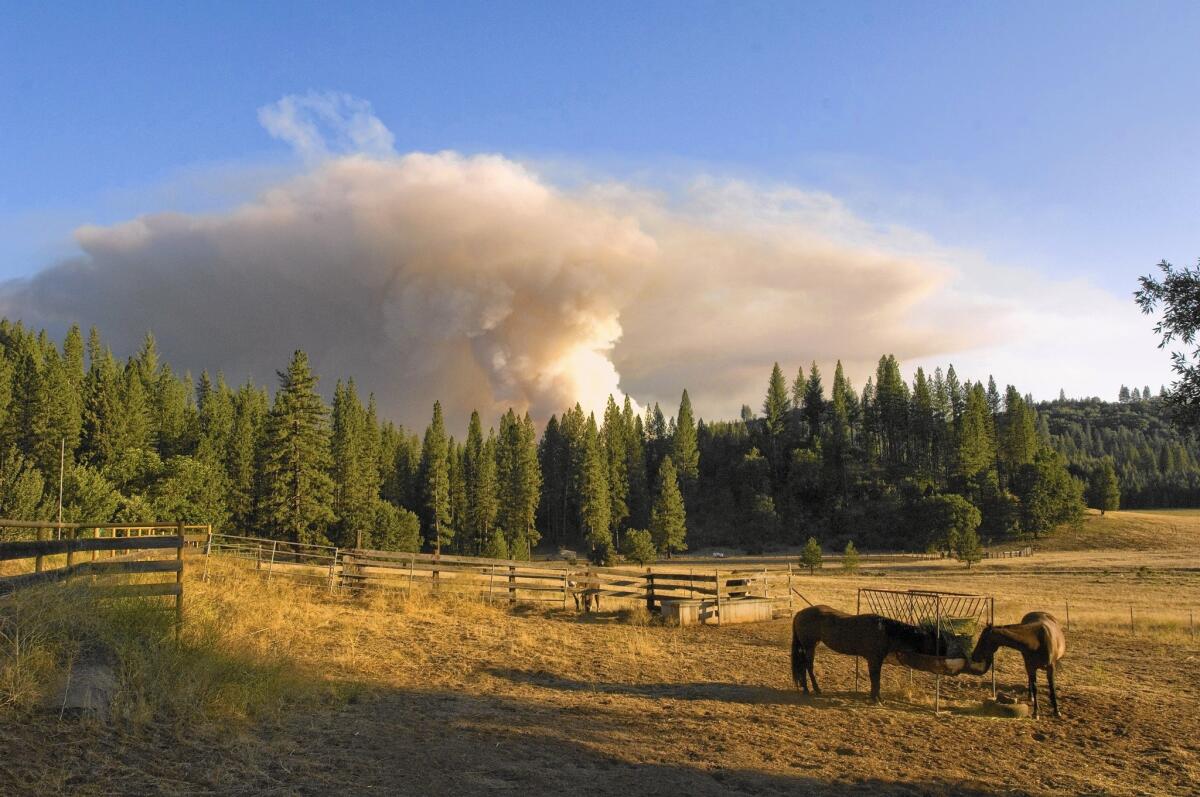Homeowners in high fire-risk areas are upset over soaring insurance rates

Horses on Jenkins Ranch off Bull Creek Road are oblivious to a smoke plume from the Telegraph fire as it blows up July 28, 2008 in Greeley Hill, Calif.
- Share via
Soaring insurance rates may accomplish what the Telegraph fire failed to do: drive the Stoffan family from their home of 10 years.
The Stoffans’ Northern California house survived the 2008 blaze, which destroyed 30 homes and 100 other structures as it charred 53 square miles west of Yosemite National Park.
But the family’s annual insurance costs doubled this year to $5,100 even though it planted a 50-foot lawn buffer around the house and installed fire-resistant landscaping, said John Stoffan, who lives there with his wife, mother and, occasionally, a son. Despite those precautions, the property carries a high fire-risk rating because the Stoffans live in Mariposa, where the already significant wildfire danger has been heightened by four years of drought.
“I’m hoping that we have a real good winter, and they lower the rating,” said Stoffan, 57, who is considering moving out of the fire area. “That’s basically what I’m waiting for at this point.”
Read more about California wildfires >>
Stoffan is among the California homeowners living near wild lands who have seen their rates increase sharply because insurance companies are increasingly wary of high fire-risk areas. Factors fueling insurer’s fears include the drought and some huge recent blazes, such as the 2013 Rim fire that burned more than 250,000 acres in and around Yosemite.
Affected residents across the state complain of fire insurance rates leaping 30% or more.
“It’s a major, major issue,” said Jim Middleton, vice chair of the Mariposa County Fire Safe Council and retired deputy chief of the Mariposa County Fire Department. “Without the insurance, you don’t have a mortgage. Without a mortgage, your house is worthless.”
Rising rates pushed San Diego County resident Mollie Jacques to switch to an insurance agency in Rancho Cucamonga, more than 100 miles from her home in Alpine.
Jacques, a registered nurse, owns three houses on adjoining parcels of land — two rentals and her own home. When this year’s insurance bill for one rental’s fire insurance came in 139% higher at $2,633, she shopped around and found a policy for $1,900. In 2012, that same house insured for $700.
She said she and her husband have done their part to protect their properties from fire danger, including keeping 5,000 gallons of water available on each property and clearing 150 feet around each house. But because the houses are surrounded by the Cleveland National Forest, the property is deemed a “wildfire area,” Jacques said.
“We were between a rock and a hard place,” said Jacques, 64. “I don’t have a choice.”
Bob Severns III, owner of Severns Insurance Agency in Hemet, said about 15% of his clients own homes in mountainous areas and have been hit with rising insurance rates. On average, he said, homeowners in these areas pay about 30% to 40% more than their counterparts on less precarious ground.
Insurance companies are protecting themselves from the high cost of replacing homes as the enduring drought increases wildfire risk and as more people each year move into fire hazard areas, experts say.
“If there is a large fire, and there is a lot of loss, they’re paying out tens of millions of dollars” if entire neighborhoods burn, said Severns, a third-generation insurance agent who does business statewide.
Although fire insurance rates have gone up, the situation is nothing as it was in Florida, where many insurers refused to issue policies after a series of particularly destructive hurricanes, leaving a majority of homeowners reliant on insurance policies of last resort, said Amy Bach, executive director of United Policyholders, an insurance consumer advocacy group.
“We still have a very healthy, competitive, private homeowners insurance market,” she said. “Whenever there is a wildfire, insurers are going to pay attention, and some insurers are going to react.”
Some homeowners have been forced to turn to the California Fair Plan Assn., an industry-financed organization that provides limited coverage. In the last few years, the number of policies taken out with the association has been flat, a sign that homeowners have been able to find other alternatives, said Anneliese Jivan, president.
Experts say more can be done to help educate homeowners on the risks they take when they move into an area close to wild lands.
“There’s a shared sense of responsibility,” said Toddi Steelman, executive director of the University of Saskatchewan’s School of Environment and Sustainability. “There’s the idea that the homeowner or property owner has a responsibility, but I think the municipalities, the cities, the counties ... also have a responsibility to encourage better building, better fire-safe practices so that we can create more resilient communities to wild land fire.”
Insurance companies also need to update their broad risk portfolios, which rank wind and hail as bigger and more costly threats than fire, Steelman said.
“Increased risk of wildfire is correlated with rising temperatures, so we know in the future, this is going to grow as a rising threat,” Steelman said.
Insurance companies frequently rely on ratings of a community’s fire suppression system to determine rates and whether an area is too high risk.
These ratings are calculated by ISO, an analytics and statistics group that provides data to insurers and brokers. Communities are ranked on a scale of 1 to 10, with Class 1 being the most prepared for a fire. Availability of emergency communications and water supply make up 50% of a community’s rating, and the preparedness of the local fire department rounds out the other half.
Beyond the official rankings, some homeowners and nonprofit organizations have taken fire prevention into their own hands.
The California Fire Safe Council, a statewide nonprofit organization, helps its local branches win federal and state grants to take on new fire suppression projects. A few years ago, the Yosemite Foothills Fire Safe Council bought a chipper with federal funds so residents could clear brush, trim trees and grind up any other potential kindling around their homes, said Rick Whybra, council chairman.
Other grants have funded programs to help elderly residents clear their wooded lots or to increase public education of what to do during a fire and how to clear a yard.
These clearances were crucial for some homes during the Telegraph fire, said Middleton of the Mariposa County Fire Safe Council, and in matters more important than insurance rates.
“When the fire came out of the river canyon, it was like a freight train,” he said. “Those people with clearances were able to survive.”
Twitter: @smasunaga
ALSO
Wildfire burning in Yosemite Valley grows to 500 acres
Brush fire in Orange County fully contained as evacuations lifted
Brush fire in La Habra and Fullerton burns 80 acres; evacuations lifted
More to Read
Inside the business of entertainment
The Wide Shot brings you news, analysis and insights on everything from streaming wars to production — and what it all means for the future.
You may occasionally receive promotional content from the Los Angeles Times.











